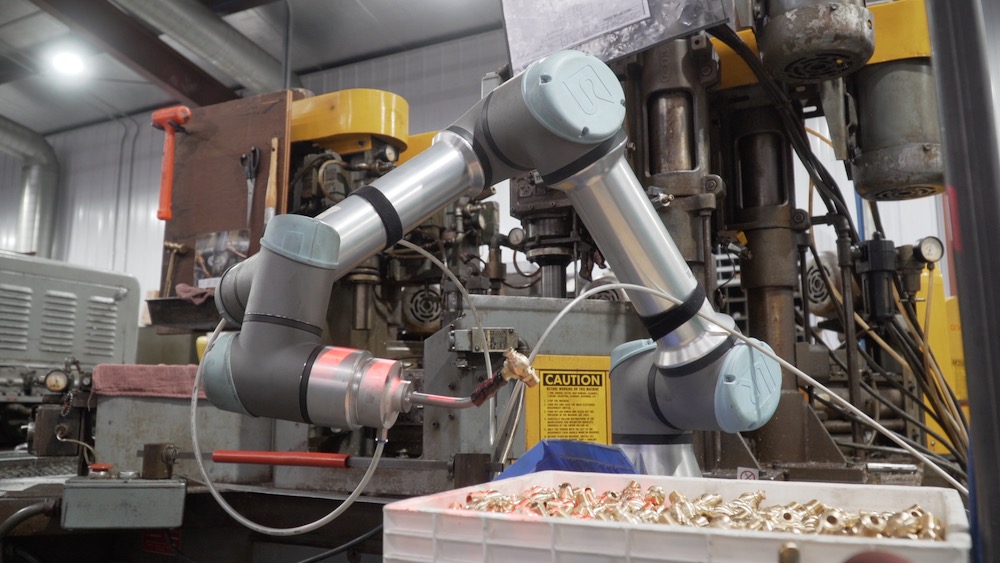|
Listen to this article  |

Universal Robots’ ActiNav machine loading system. | Photo Credit: Universal Robots
Although it faced some major supply chain issues, Teradyne’s industrial automation group pulled in $91 million in revenue in Q3 2021. The portfolio includes AutoGuide Mobile Robots, Energid, Mobile Industrial Robots (MiR) and Universal Robots (UR).
Once again, the revenue came on the backs of UR and MiR. Universal Robots earned a record $78 million in revenue for its collaborative robot arms. This marks a 2.6% increase from the $76 million UR earned in Q2 2021, but it’s a massive 46% increase year over year and a 31% increase from Q3 2019. The earnings from Energid, a Bedford, Mass.-based robot control software specialist, are combined with UR’s.
MiR generated $13 million in sales for its autonomous mobile robots (AMRs). That is down about 19% from the $16 million it earned in the second quarter. The $16 million, however, does represent a 27% increase year over year and a 35% increase from Q3 2019. AutoGuide, which continues to reset, wasn’t mentioned during Teradyne’s Q3 earnings call.
You can view Teradyne’s Q3 earnings presentation here (PDF), listen to the earnings call here, and read a transcript of the call here.
Supply chain challenges
The Robot Report talked yesterday with Greg Smith, president of Teradyne’s industrial automation group. He said supply chain issues, which are impacting many companies across different industries, constrained the group’s revenue, causing lead times to stretch out by about two weeks.
“The longer lead time equates to revenue that we would’ve liked to ship. That revenue will carry over to the next quarter,” said Smith, who was speaking from MiR’s headquarters in Denmark. “We’re keeping our heads above water, but this is definitely a new challenge to handle this perfect storm where supply is constrained and demand is rising fast.”
Smith said a shortage of electronic components, specifically chips, are slowing down the process of building the robots.
“Inside of robots you use devices that are very similar to, or sometimes exactly the same as, those that go into cars,” he said. “All of the supply constraints are tough on automakers, and we’re scrambling after parts the same way they are.”
Teradyne, of course, is tapped into the semiconductor industry. Smith said Teradyne expects the chip shortage to persist through at least the first half of 2022.
Supply chain issues, the company said, will limit growth of its industrial automation group to 30-40% in 2021.

Universal Robots president Kim Povlsen on the record revenue: “Almost everywhere we operate we see the manufacturing sector facing considerable challenges – such as workforce shortages and supply chain disruption – which can be tackled through the use of collaborative automation.”
Untapped market opportunity
Challenges aside, Teradyne said MiR and UR grew 40% and 50%, respectively, during the first 9 months of 2021. But the reasons for the growth are different.
“At UR, it’s a combination of increasing sales for existing tasks and the expanding number of UR+ offerings, making it easier for customers to deploy our cobots to do new applications,” Mark E. Jagiela, president, CEO and director, Teradyne, said during the Q3 earnings call. “At MiR, the story is about new products. The MiR250, which was introduced just as COVID hit in March of last year, is now our largest seller by far. This year, we added the MiR Hook to the 250 family to expand its applications into tugging. We’ve introduced higher payload products such as the MiR600 and 1350 to expand our footprint in the fast growing logistics market. ”
So just how large is the opportunity for cobot arms and AMRs? It’s a question Teradyne has struggled with.
“The question I get internally is that if you’re growing 40% year on year, why can’t you grow faster? Trying to come up with a model for the dynamics of the market is difficult,” Smith said. “We’ve always struggled trying to get good market research about cobots and AMRs.”
So Teradyne tasked itself with coming up with those numbers. It claims cobots are used in fewer than 1.5% of 9 million potential applications, while AMRs are used in fewer than 2.5% of 7 million potential applications. Jagiela said UR owns approximately 45% of the cobot market, while the AMR space lacks a similar, dominant player.
“The things that limit how fast you can grow are ease of use and awareness,” said Smith. “Ease of use is a primary thing we’re working on, and we need to continue to figure out how to reach new potential customers.”
“The long-term outlook in industrial automation remains very bright,” Jagiela said during the Q3 earnings call. He added, “the fact that our penetration of today’s servable market is in the low single digits and that the servable market continues to expand each year with product enhancements, sets up a fantastic future.”
Credit: Source link


Comments are closed.